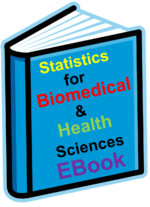Statistics for life and health sciences EBook
From Socr
| Line 31: | Line 31: | ||
==Chapter II: Data and variability== | ==Chapter II: Data and variability== | ||
* Data | * Data | ||
| + | * Measures of center, dispersion/variation, skewness, flatness | ||
* Design of experiments | * Design of experiments | ||
* R data management (Import and Export) | * R data management (Import and Export) | ||
| Line 42: | Line 43: | ||
==Chapter IV: Probability Models== | ==Chapter IV: Probability Models== | ||
| + | * Fundamentals | ||
| + | * Rules for Computing Probabilities | ||
| + | * Probabilities Simulations | ||
| + | * Counting Principles | ||
==Chapter V: Statistical Models== | ==Chapter V: Statistical Models== | ||
| Line 61: | Line 66: | ||
* Law of Large Numbers (First Fundamental Law of Probability Theory) | * Law of Large Numbers (First Fundamental Law of Probability Theory) | ||
* Central Limit Theorem (Second Fundamental Law of Probability Theory) | * Central Limit Theorem (Second Fundamental Law of Probability Theory) | ||
| + | * Relations between Distributions (Distributome) | ||
==Chapter VIII: Multivariate Statistics== | ==Chapter VIII: Multivariate Statistics== | ||
* Parametric (simple and multivatiate) regression | * Parametric (simple and multivatiate) regression | ||
| - | * Parametric ANOVA | + | * Parametric ANOVA/ANCOVA/MANCOVA |
| + | * Logistic Regression | ||
* Parametric assumptions and model validation | * Parametric assumptions and model validation | ||
* Non-parametric linear modeling | * Non-parametric linear modeling | ||
| Line 70: | Line 77: | ||
* Genome-wide association studies (GWAS) | * Genome-wide association studies (GWAS) | ||
| - | ==Chapter IX:== | + | ==Chapter IX: Multinomial Experiments and Inference== |
| + | * Chi-square | ||
| - | ==Chapter | + | ==Chapter X: Parameter Estimation== |
| + | * MOM | ||
| + | * MLE | ||
| - | ==Chapter | + | ==Chapter XI: Bayesian Inference== |
| - | ==Chapter | + | ==Chapter XII: Dimensionality Reduction== |
| + | * PCA | ||
| + | * ICA | ||
| - | ==Chapter | + | ==Chapter XIII: Classification Methods== |
| + | * Supervised classification methods (Support Vector Machines, SVM, ADABOOST) | ||
| + | * Unsupervised (K-means clustering, hierarchical clustering) | ||
| + | |||
| + | == Chapter XIV: Survival Analysis== | ||
| + | |||
| + | == Chapter XV: Mixture modeling== | ||
| + | |||
| + | == Chapter XVI: Causality== | ||
| + | |||
| + | ==Appendix== | ||
<hr> | <hr> | ||
{{translate|pageName=http://wiki.stat.ucla.edu/socr/index.php?title=Statistics_for_life_and_health_sciences_EBook}} | {{translate|pageName=http://wiki.stat.ucla.edu/socr/index.php?title=Statistics_for_life_and_health_sciences_EBook}} | ||
Revision as of 23:49, 18 March 2013
Welcome to the UCLA Statistics for the Biomedical and Health Sciences (Stats 13) electronic book (EBook).
Preface
This is an Internet-based probability and statistics for biomedical and health sciences EBook. The materials, tools and demonstrations presented in this EBook would are used for the UCLA Statistics 13 course. The EBook is developed, updated and manages by the UCLA Statistics faculty teaching this course over the years. Many other instructors, researchers, students and educators have contributed to this EBook.
There are four novel features of this Statistics EBook. It is community-built and allows easy modifications and customizations, completely open-access (in terms of use and contributions), blends information technology, scientific techniques, heterogeneous data and modern pedagogical concepts, and is multilingual.
Format
Each section in this EBook includes
- Motivation
- Concepts, definitions, formulations
- Examples
- Small (mock-up) and real (research-derived) data
- Webapp demonstration with real data (HTML5)
- R programming
- Problems
Pedagogical Use
...
Copyright
The Probability and Statistics EBook is a freely and openly accessible electronic book for the entire community under CC-BY license ...
Chapter I: Introduction to Statistics
- Natural Biomedical and Health Research Studies
- Data-driven Statistics
- Uses and Abuses of Statistics
- Statistical Software Tools
Chapter II: Data and variability
- Data
- Measures of center, dispersion/variation, skewness, flatness
- Design of experiments
- R data management (Import and Export)
- Histograms, densities and summary statistics
Chapter III: Randomization-based statistical inference
- Samples, Populations, Repeated Samples, Resampling
- Bootstrapping
- Testing one, two or more samples
- Confidence intervals
Chapter IV: Probability Models
- Fundamentals
- Rules for Computing Probabilities
- Probabilities Simulations
- Counting Principles
Chapter V: Statistical Models
Chapter VI: Parametric Model-based Inference
- Hypothesis testing foundations
- Type I and II errors, Power, sensitivity, specificity
One sample inference
- T-Test
- Normal Z-test
- Confidence intervals
Two sample inference
- Independent samples
- Paired samples
Chapter VII: Limiting Theorems
- Law of Large Numbers (First Fundamental Law of Probability Theory)
- Central Limit Theorem (Second Fundamental Law of Probability Theory)
- Relations between Distributions (Distributome)
Chapter VIII: Multivariate Statistics
- Parametric (simple and multivatiate) regression
- Parametric ANOVA/ANCOVA/MANCOVA
- Logistic Regression
- Parametric assumptions and model validation
- Non-parametric linear modeling
- Randomization and Resampling based multivariate inference
- Genome-wide association studies (GWAS)
Chapter IX: Multinomial Experiments and Inference
- Chi-square
Chapter X: Parameter Estimation
- MOM
- MLE
Chapter XI: Bayesian Inference
Chapter XII: Dimensionality Reduction
- PCA
- ICA
Chapter XIII: Classification Methods
- Supervised classification methods (Support Vector Machines, SVM, ADABOOST)
- Unsupervised (K-means clustering, hierarchical clustering)
Chapter XIV: Survival Analysis
Chapter XV: Mixture modeling
Chapter XVI: Causality
Appendix
Translate this page:

